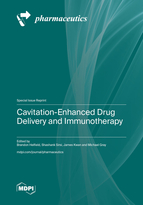Cavitation-Enhanced Drug Delivery and Immunotherapy
A special issue of Pharmaceutics (ISSN 1999-4923). This special issue belongs to the section "Drug Delivery and Controlled Release".
Deadline for manuscript submissions: closed (10 June 2023) | Viewed by 25927
Special Issue Editors
2. Department of Biology, Concordia University, Montreal, QC H3G 1M8, Canada
Interests: ultrasound; microbubbles; immunotherapy; sonoporation; cavitation; targeted drug delivery; acoustics; focused ultrasound; immunomodulation
Interests: ultrasound; focused ultrasound; ultrasound contrast agents; drug delivery; sonoporation; sonopermeation
Special Issues, Collections and Topics in MDPI journals
Interests: stimuli-responsive microparticles and nanoparticles; ultrasound; cavitation; sonochemistry; physical acoustics
Interests: ultrasound-mediated drug delivery; cavitation monitoring techniques
Special Issues, Collections and Topics in MDPI journals
Special Issue Information
Dear Colleagues,
We are pleased to invite you to contribute to this Special Issue intended to highlight new developments in Cavitation-Enhanced Drug Delivery and Immunotherapy. This rapidly evolving field has been buoyed in recent years by the development of methods harnessing the activity of ultrasound-stimulated bubbles known as cavitation. When properly controlled, cavitation can help overcome physical barriers to drug delivery whilst providing readily measurable information for timely quantitative feedback and treatment guidance. Microbubble-assisted therapies have demonstrated impressive advancements in clinical trials and pre-clinical areas, including applications in neurology, oncology, cardiology, and beyond.
This Special Issue will cover topics including the design of new cavitation nuclei constructs, cavitation-assisted immunotherapies and immunomodulation, targeted drug or gene delivery, and dual microbubble imaging and therapeutic approaches. In addition to manuscripts that investigate applications in drug delivery and immunotherapy, we also welcome numerical and/or experimental mechanistic studies, including but not limited to single-cell or single-bubble studies that glean insight into the biophysics of this technology.
This Special Issue is open to original research and review articles. We look forward to receiving your contributions.
Dr. Brandon Helfield
Dr. Shashank Sirsi
Dr. James Kwan
Dr. Michael Gray
Guest Editors
Manuscript Submission Information
Manuscripts should be submitted online at www.mdpi.com by registering and logging in to this website. Once you are registered, click here to go to the submission form. Manuscripts can be submitted until the deadline. All submissions that pass pre-check are peer-reviewed. Accepted papers will be published continuously in the journal (as soon as accepted) and will be listed together on the special issue website. Research articles, review articles as well as short communications are invited. For planned papers, a title and short abstract (about 100 words) can be sent to the Editorial Office for announcement on this website.
Submitted manuscripts should not have been published previously, nor be under consideration for publication elsewhere (except conference proceedings papers). All manuscripts are thoroughly refereed through a single-blind peer-review process. A guide for authors and other relevant information for submission of manuscripts is available on the Instructions for Authors page. Pharmaceutics is an international peer-reviewed open access monthly journal published by MDPI.
Please visit the Instructions for Authors page before submitting a manuscript. The Article Processing Charge (APC) for publication in this open access journal is 2900 CHF (Swiss Francs). Submitted papers should be well formatted and use good English. Authors may use MDPI's English editing service prior to publication or during author revisions.
Keywords
- ultrasound
- microbubbles
- immunotherapy
- sonoporation
- cavitation
- targeted drug delivery
- acoustics
- focused ultrasound
- immunomodulation







